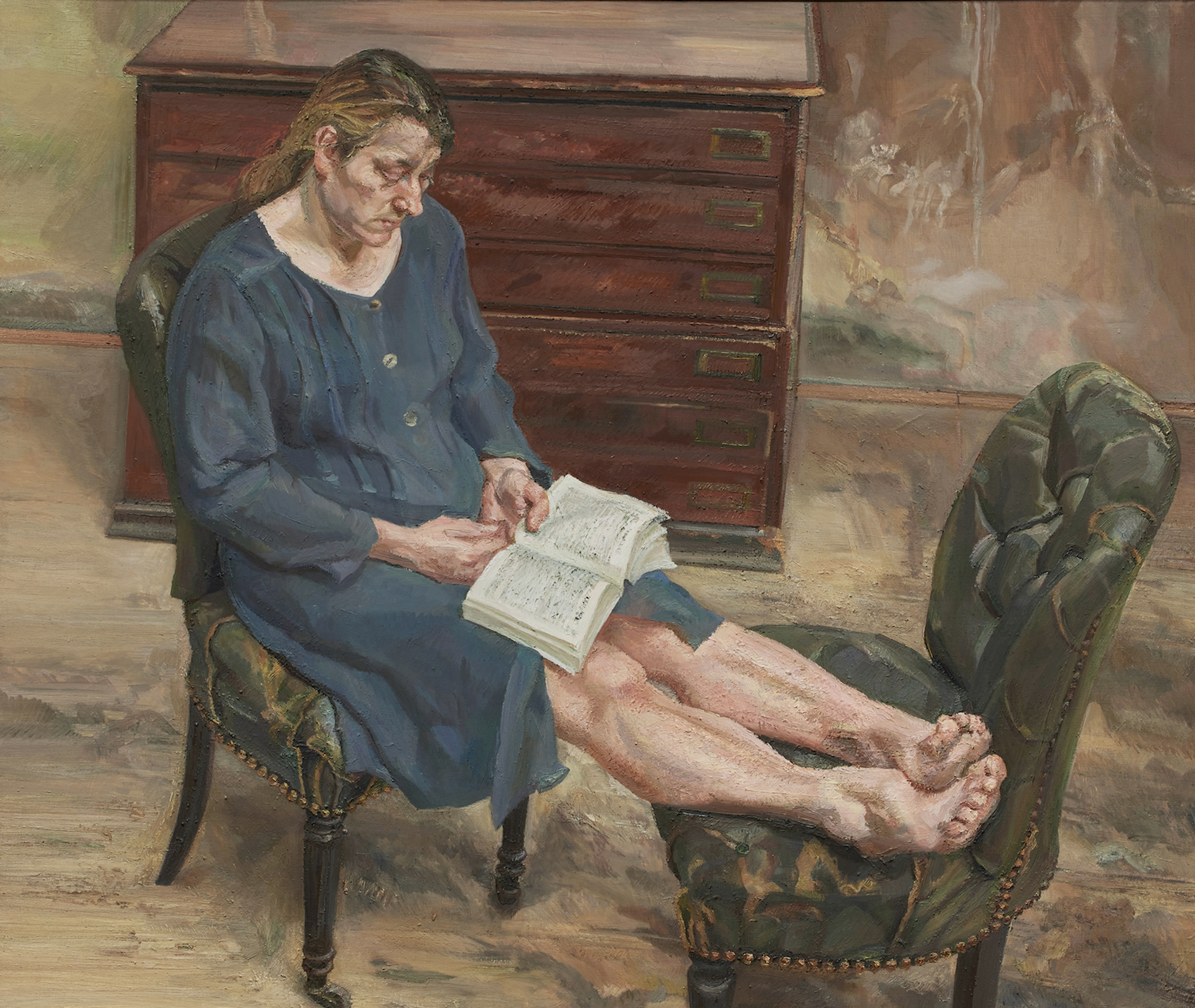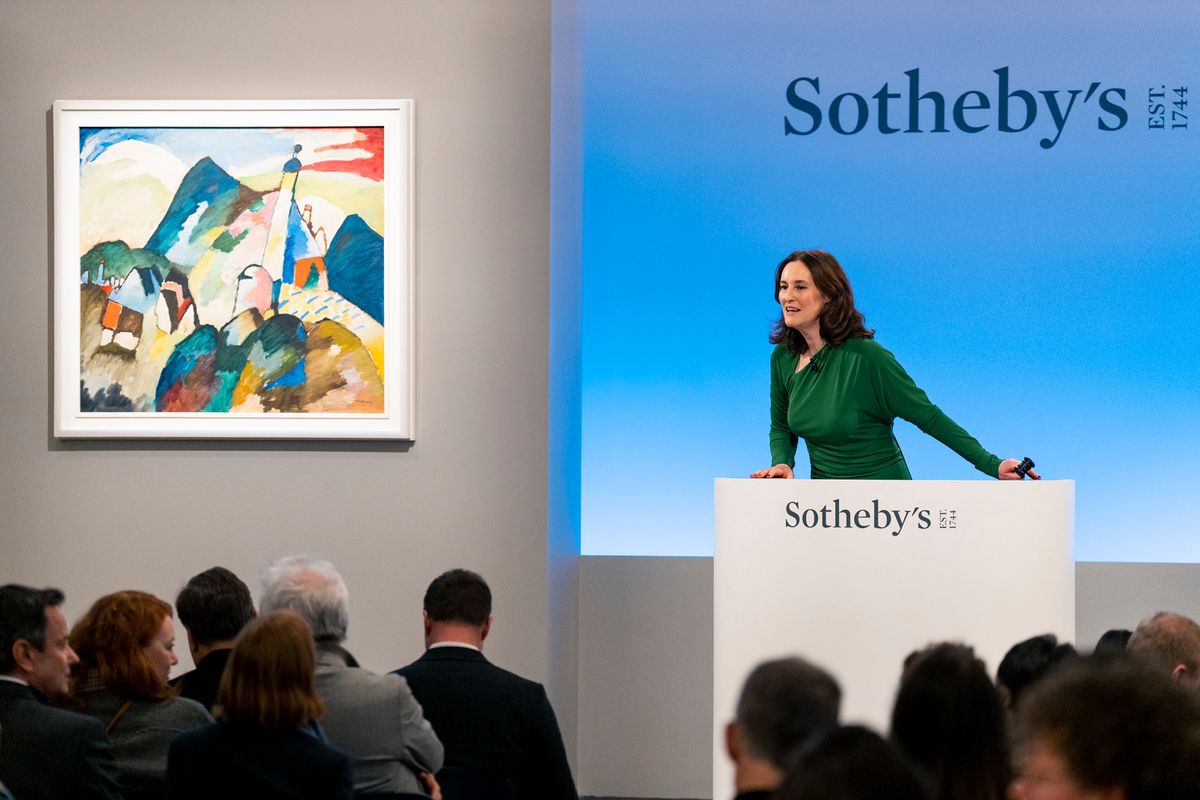All hope that Sotheby's Modern and contemporary London evening sales on Wednesday would feel anything but procedural evaporated shortly before the bidding began. Around 20 minutes before crowds entered the salesroom, it was announced that Edvard Munch's monumental Dance on the Beach (1906-07)—the sale's only eight figure lot with no guarantee—would now carry an irrevocable bid.
The four-metre-wide painting, which was hidden from Nazis in a remote barn in a Norwegian forest and had not come to market in 80 years, hammered for £14.5m against an unusually wide £12m to £20m estimate. A few lots later, the evening's top prize was brought out. Wassily Kandinsky's Murnau With Church II (1910)—a semi-abstract painting that was the subject of a 12-year long restitution battle between the Dutch city of Eindhoven and the heirs of two Jewish German collectors who died in Auschwitz—was being closely watched, as its third-party guarantee made it almost certain to break the artist's auction record. It did so with just one phone bid from the guarantor, and embodied the tone of the night—solid enough and within range, but lacking fireworks or fervour.
Still, following the tepid results of Christie's London sale on Tuesday, Sotheby's can breathe a sigh of relief. And so can the industry players watching these auctions as the first test of the market's top end this year. The evening was split into two sales, beginning with The Now, a white-glove 20-lot ultra-contemporary affair which surpassed its high estimate of £9.3m to make £10.9m (all totals are calculated without fees unless specified otherwise) and achieved records for seven artists including Michael Armitage and Miriam Cahn. This was followed by the Modern and contemporary section (with a bit of Post-Impressionism snuck in), which made £136.9m from 38 lots with an 83% sell through rate, just edging into its presale estimate of £133.1m to £178.3m.
Compared to Sotheby's March 2022 evening sales in London, which shifted 53 lots for a total of £162m, yesterday's offering was notably slimmer—"quality over quantity", says James Sevier, Sotheby's European head of contemporary art. Like his Christie's counterparts, he seems enviably unfazed by the effects of Brexit on the market's top end, pointing out that London has always been "the most global of Sotheby's locations to bid in". And yesterday, Asian collectors stepped up to the plate, bidding on more than half of the The Now sale and also securing key Modern and contemporary key lots, including Gerhard Richter's Abstraktes Bild for £20m.

Lucian Freud's Ib Reading (1997)
Courtesy of Sotheby's
As is common, Sotheby's had pre-ordained a number of its headline achievements, most notably a press release blast announcing that five works—all guaranteed—had achieved in excess of £15m, which is "more than at any Sotheby’s London sale since 2015". A headline like this fails to mention that one of these five works, a huge Freud painting depicting the artist's daughter, would likely have fallen flat had it not been rescued by an offer from the contemporary German art specialist Bastienne Leuthe on behalf of its irrevocable bidder—it quietly hammered at its £15m low estimate. "The big ticket stuff was set at high levels," says the London adviser Hugo Nathan, "meaning that it didn't soar". Nonetheless, he adds, "healthy estimates are still a reassuring sign".
Some buyers made relative bargains as it seemed that yesterday's bidders, while certainly present and spending, were offering only as much as they absolutely needed to, especially on pre-1980 works. One of the largest-ever works by Robert Delaunay to come to auction—and the evening's most expensive non-guaranteed work— went quickly for £6m, below its £7m low estimate. A still life by Maurice de Vlaminck bearing an impressive exhibition history that includes the Museum of Modern Art in New York hammered at a steal for £650,000 against its £800,000 low estimate.
Nonetheless, pockets of spirited bidding were evidenced across the sale, and several lots in the seven figures performed well. One with particular star power was František Kupka's Complexe, being sold from the collection of the late actor Sean Connery to benefit his foundation. A three-way bidding war drove the lot up past its £2.8m high estimate, and it eventually hammered for £3.8m to a phone bidder via the specialist Tessa Kostrzewa.

Mohammed Sami's Family Issues I (2019)
Courtesy of Sotheby's
Meanwhile The Now—a sale that, compared to its equivalents at Phillips and Christie's feels much more curated and in keeping with critical as well as commercial mores—suggests that the contracting ultra-contemporary market is not yet about to flatline, even if the froth is no longer there. Two artists made their auction debut: Mohammed Sami, the subject of a critically acclaimed Camden Arts Centre show (until 28 May), whose Family Issues I (2019) made £355,600, and Emma Webster, whose painting Primavera (2019) sold to a collector in Asia for £320,000.
An eye-watering £480,000 was achieved by The Coal Seller (2020-21) by Raghav Babbar, who at 25-year-old was the evening's youngest artist and made his new auction record. Multiple lots in this section received more than eight bidders each, including Julien Nguyen's Study for the Temptation of Christ (2019), which had already changed hands three times in four years, and drew attention from 10 bidders before hammering at £320,000 to a collector bidding via senior specialist Fergus Duff.
Notably, The Now also saw very deep bidding. The same collector liaising via Sotheby’s Los Angeles-based senior specialist Jackie Wachter on the phone snapped up three paintings—by Cecily Brown, Shara Hughes and Nicolas Party— in quick succession, spending £4.4m in the space of 20 minutes. Similarly, the same buyer of the Sami also purchased Michael Armitage's Muliro Gardens (baboons) (2016)—only the second work by the coveted, White Cube-backed painter to come to auction—which made the artist's record at £1.5m.
Welcome inclusions in this section included the less commercially driven Relational Aesthetics practitioner Philippe Parreno—better known for room-spanning installations than sellable objects. His light-based sculpture Marquee M1535 (2015) received a rather flat reception compared to the buzz generated by the wet paintings that had preceded, and it hammered at £160,000, near its £150,000 low estimate, with just two bids. Still, its presence gestured towards the potential for this sale in setting tastes, as well as following them.


